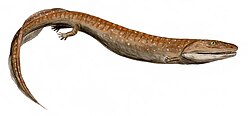This article needs additional citations for verification .(October 2008) |
| Letognathus Temporal range: Early Carboniferous | |
|---|---|
| Scientific classification | |
| Domain: | Eukaryota |
| Kingdom: | Animalia |
| Phylum: | Chordata |
| Clade: | Sarcopterygii |
| Clade: | Tetrapodomorpha |
| Class: | † Rhizodontida |
| Order: | † Rhizodontiformes |
| Family: | † Rhizodontidae |
| Genus: | † Letognathus Brazeau, 2005 |
| Type species | |
| Letognathus hardingi (Dawson, 1868) | |
| Synonyms | |
| |
Letognathus is a genus of rhizodont tetrapodomorph that lived during the Carboniferous period. [1] Its remains come from the Blue Beach Member of the Horton Bluff Formation, near Hantsport, Nova Scotia. Like most rhizodonts, it was of relatively large size, had a large recurved fang at the symphysis of the lower jaw, and a row of three coronoid fangs along the length of the jaw in addition to its marginal dentition. Letognathus is important for rhizodont systematics because it retains a number of primitive features, such as ossified Meckel's cartilage, are not found in the genera Rhizodus and Strepsodus .





